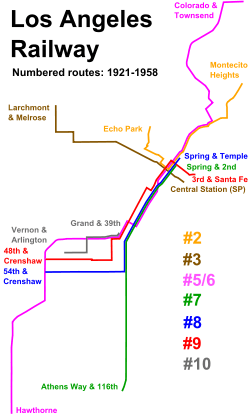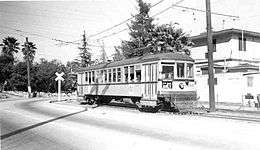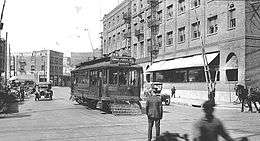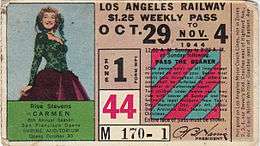Los Angeles Railway
 | |
| Overview | |
|---|---|
| Locale |
Los Angeles, California, and its suburbs |
| Transit type | Streetcar |
| Number of lines | 20 |
| Operation | |
| Began operation | 1901 |
| Ended operation | 1963 |
| Operator(s) | Los Angeles Railway |
| Reporting marks | LARy |
| Technical | |
| Track gauge | 3 ft 6 in (1,067 mm) |
| Minimum radius of curvature | ? |
%2C_1942.jpg)
.svg.png)
The Los Angeles Railway (also known as Yellow Cars, LARy, and later Los Angeles Transit Lines) was a system of streetcars that operated in Central Los Angeles and surrounding neighborhoods between 1901 and 1963. It operated on 3 ft 6 in (1,067 mm) narrow gauge tracks. The company carried many more passengers than the Pacific Electric Railway's Red Cars, which served a larger area of Los Angeles.
History
Early years
The system was purchased by railroad and real estate tycoon Henry E. Huntington in 1898 and started operation in 1901. At its height, the system contained over 20 streetcar lines and 1,250 trolleys, most running through the core of Los Angeles and serving such neighborhoods as Crenshaw, West Adams, Leimert Park, Exposition Park, Echo Park, Westlake, Hancock Park, Vernon, Boyle Heights and Lincoln Heights.
Decline
The system was sold in 1945 by Huntington's estate to National City Lines, a company that was purchasing transit systems across the country.[1] National City Lines, along with its investors that included Firestone Tire, Standard Oil of California (now Chevron Corporation) and General Motors, were later convicted of conspiring to monopolize the sale of buses and related products to local transit companies controlled by National City Lines and other companies[n 1] in what became known as the General Motors streetcar conspiracy. National City Lines purchased Key System, which operated streetcars systems in Northern California, the following year.
The company was renamed as Los Angeles Transit Lines.[2] The new company introduced 40 new ACF-Brill trolley buses which had originally been intended for the Key System streetcar system in Oakland which was being converted by National City Lines to buses in late 1948.
Many lines were converted to buses in the late 1940s and early 1950s.[2]
Public ownership and finale
The last remaining lines were taken over by the Los Angeles Metropolitan Transit Authority (a predecessor to the current agency, The Los Angeles County Metropolitan Transportation Authority (Metro)) along with the remains of the Pacific Electric Railway in 1958. The agency removed the remaining five streetcar lines (J, P, R, S and V) and two trolley bus lines (2 and 3), replacing electric service with diesel buses on March 31, 1963.[3]
Proposed developments
Restoration
In May 2011, the Los Angeles County Metropolitan Transportation Authority, the city of Los Angeles, and several stakeholders began conducting studies and public meetings to identify the feasibility of restoring streetcar service downtown.[4]
List of routes

- 2 Line – Rampart area of Echo Park to Montecito Heights; by way of Belmont Avenue, Loma Drive, 3rd Street, Flower Street, 5th Street, Broadway, Pasadena Avenue, Avenue 26, and Griffin Avenue.
- 3 Line – Skid Row to Hollywood; by way of 5th Street, 6th Street, private ROW, 3rd Street, and Larchmont Boulevard.
- 5 Line – Hawthorne to Eagle Rock; by way of Hawthorne Boulevard, Market Street (Inglewood), private ROW paralleling Redondo Boulevard (later Florence Avenue), Crenshaw Boulevard, Leimert Boulevard (dedicated tracks in center divider), Santa Barbara Avenue, Grand Avenue, Jefferson Boulevard, Main Street, Broadway, Pasadena Avenue, Avenue 20, Figueroa Street, Cypress Avenue, Eagle Rock Boulevard, and Colorado Boulevard.
- 7 Line – South Los Angeles to Los Angeles Plaza Historic District; by way of Broadway, Main Street, and Spring Street.
- 8 Line – Leimert Park to Los Angeles Plaza Historic District; by way of 54th Street, Broadway, Main Street, and Spring Street.
- 9 Line – Leimert Park to the Wholesale District, by way of 48th Street, Hoover Street, Grand Avenue, Pico Boulevard, Broadway, and 2nd Street.
- 10 Line – Leimert Park to Lincoln Heights; by way of Vernon Avenue, Dalton Avenue, Martin Luther King Boulevard, Grand, Pico Boulevard, Broadway, and Lincoln Park Avenue.
- A Line – Mid City to Echo Park; by way of Adams Boulevard, Kensington Street, Venice Boulevard, Broadway, Temple Street, Edgeware Road, and Douglas Street.
- B Line – Nevin to City Terrace; by way of Ascot Avenue, Hooper Avenue, 12th Street, Main Street, Brooklyn Avenue, Evergreen Avenue, Wabash Avenue, and City Terrace Drive.
- D Line – Westlake to Skid Row; by way of Bonnie Brae Street, 3rd Street, Alvarado Street, 6th Street, and 5th Street.
- F Line – Athens to Boyle Heights; by way of Vermont Avenue, Hoover Street, Santa Barbara Avenue, Grand Avenue, Jefferson Boulevard, Main Street, 3rd Street, 4th Place, 4th Street, and Fresno Street.
- G Line – Nevin to South Park; by way of McKinley Avenue, Jefferson Boulevard, Griffith Avenue, Washington Boulevard, and Main Street.
- H Line – South Los Angeles to East Hollywood; by way of San Pedro Street, 7th Street, Broadway, 6th Street, Rampart Boulevard, Beverly Boulevard, Heliotrope Drive, and Melrose Avenue.
- I Line -

- J Line – Jefferson Park to Huntington Park; by way of Jefferson Boulevard, Central Avenue, Vernon Avenue, and Pacific Boulevard.
- K Line -

- L Line – East Hollywood to Mid-City; by way of Lexington Avenue, Madison Avenue, Temple Street, Broadway, and Olympic Boulevard.
- N Line – Koreatown to South Park; by way of 8th Street and 9th Street.
- O Line – South Los Angeles to Lincoln Heights; by way of Main Street.
- P Line – Mid-City to City Terrace; by way of Pico Boulevard, Main Street, 1st Street, Gage Avenue, Hammel Street, and Record Avenue.
- R Line – Hancock Park to East Los Angeles; by way of 3rd Street, Vermont Avenue, 7th Street, Boyle Avenue, and Whittier Boulevard.
- S Line – Watts to East Hollywood; by way of Central Avenue, Florence Avenue, Avalon Boulevard, Vernon Avenue, Vermont Street, 3rd Street, and Western Avenue.
- U Line – Nevin to West Adams; by way of Central Avenue, Jefferson Boulevard, Vermont Street, and 27th Street.
- V Line – Nevin to East Hollywood; by way of Santa Fe Avenue, 7th Street, and Vermont Street.
- W Line – Mid-City to Highland Park; by way of Washington Boulevard, Figueroa Street, 6th Street, Broadway, Avenue 20, Figueroa Street, and York Boulevard.
Gallery
 The LARy's Soto Street sub station, c. 1913.
The LARy's Soto Street sub station, c. 1913. Unit #1407, one of 250 streetcars built for the LARy by the St. Louis Car Company, turns up Marmion Way. The air-operated folding doors were added in the 1930s to permit one-man operation.
Unit #1407, one of 250 streetcars built for the LARy by the St. Louis Car Company, turns up Marmion Way. The air-operated folding doors were added in the 1930s to permit one-man operation. A P Line trolley crossing Alameda Street at 1st Street in Little Tokyo as it heads for Boyle Heights in c. 1918.
A P Line trolley crossing Alameda Street at 1st Street in Little Tokyo as it heads for Boyle Heights in c. 1918. Weekly Pass, Oct 29 – Nov 4, 1944
Weekly Pass, Oct 29 – Nov 4, 1944
See also
References
- ↑ "Finding Aid for the Los Angeles Railway Corporation Legal Records and Correspondence".
the controlling interest remained part of the Huntington estate until 1945 when the Fitzgerald Brothers purchased those shares. LARy became part of the National City Lines, was renamed the Los Angeles Transit Lines, and eventually the streetcars were phased out, replaced by motor buses.
- 1 2 "Book Review: Los Angeles Railway Yellow Cars".
By the end of World War II, the Huntington estate sold its majority interest to Chicago-based National City Lines. LARY became the Los Angeles Transit Lines, and bigger changes were in store. Many lines were converted to bus operation through the late forties and fifties. Never mind that NCL was partially owned by bus, tire, and gasoline suppliers. Though Federal anti-trust action was taken against NCL, the damage was already done. Los Angeles was officially in love with the automobile.
- ↑ "Streetcars Go for Last Ride". Los Angeles Times, March 31, 1963, Page N5. Link via ProQuest.
- ↑ Possible restoration
Notes
Further reading
- Bottles, Scott (1991). Los Angeles and the Automobile: The Making of the Modern City. University of California Press. ISBN 0-520-07395-9.
- Copeland, P. Allen (2002). California Trolleys In Color, Volume 1: San Diego and Los Angeles. Scotch Plains, NJ: Morning Sun Books, Inc. ISBN 1-58248-076-1.
- Easlon, Steven L. (1973). Los Angeles Railway Through the Years. Anaheim, CA: Easlon Publications.
- Fogelson, Robert (1967). The Fragmented Metropolis Los Angeles: 1850-1930. Cambridge, Massachusetts: Harvard University Press.
- Freidricks, William B. (1992). Henry Huntington and the Creation of Southern California. Columbus, OH.: Ohio University Press. ISBN 0-8142-0553-4.
- Hendricks, William O. (1971). Moses Sherman: A Pioneer Developer of the Pacific Southwest. Corona Del Mar, CA: The Sherman Foundation.
- Longstreth, Richard (1997). City Center to Regional Mall: Architecture, the Automobile, and Retailing in Los Angeles, 1920-1950. Cambridge, Massachusetts: MIT Press.
- Moreau, Jeffrey (1964). The Los Angeles Railway Pictorial. Los Angeles, CA: Pacific Bookwork.
- Perry, Louis B. & Richard S Perry (1963). A History of the Los Angeles Labor Movement, 1911-1941. Berkeley and Los Angeles, CA: University of California Press.
- Post, Robert C. (September 1970). "The Fair Fare Fight: An Episode in Los Angeles History". Southern California Quarterly. Historical Society of Southern California.
- Post, Robert C. (1989). Street Railways and the Growth of Los Angeles. San Marino, CA: Golden West Books. ISBN 0-87095-104-1.
- Sitton, Tom (2005). Los Angeles Transformed: Fletcher Bowron’s Urban Reform Revival, 1938-1953. Albuquerque, NM: University of New Mexico Press.
- Sitton, Tom (1992). John Randolph Haynes; California Progressive. Stanford, CA: Stanford University Press.
- Squier, Gerald (October 2013). "Los Angeles Railway". Motor Coach Age. Motor Bus Society.
- Squier, Gerald (January 2015). "Los Angeles Transit Lines". Motor Coach Age. Motor Bus Society.
- Stimson, Grace Heliman (1955). Rise of the Labor Movement in Los Angeles. Berkeley, CA: University of California Press.
- Swett, Ira (1951). Los Angeles Railway; Interurbans Special #11. Los Angeles, CA: Interurban Press.
- Swett, Ira (1952). Los Angeles Railway All-time Roster; Interurbans Special #12. Los Angeles, CA: Interurban Press.
- Swett, Ira (1962). Los Angeles Railway Pre-Huntington Cars 1890-1902; Interurbans Special #22. Los Angeles, CA: Interurban Press.
- Swett, Ira (1964). Die Day In LA; Interurbans Special #35. Los Angeles, CA: Interurban Press.
- Thorpe, James (1994). Henry Edwards Huntington: A Biography. Berkeley, CA: University of California Press.
- Walker, Jim (1977). The Yellow Cars of Los Angeles. Glendale, CA: Interurban Press. ISBN 0-916374-25-4.
- Walker, Jim (2007). Images of Rail Series: Los Angeles Railway Yellow Cars. Charleston, SC: Arcadia Publishing.
- Wilson, Jane (1990). Gibson, Dunn & Crutcher, Lawyers: An Early History. Torrance, CA: Gibson, Dunn & Crutcher.
External links
| Wikimedia Commons has media related to Los Angeles Railway. |
- Restoration of Historic Streetcar Service in Downtown Los Angeles Current MTA efforts to restore the streetcars downtown
- goLAstreetcar An initiative to bring streetcar services back to downtown Los Angeles
- Los Angeles Railway gallery by Metro Transportation Library and Archive
- Los Angeles Transit Lines Training Film From YouTube
- Orange Empire Railway Museum official website
- wetzel/pery.htm Tours in a Bygone Era
- Electric Railway Historical Society list of ninety seven Ira Swett Interurban Press releases, including coverage of Los Angeles Railway.